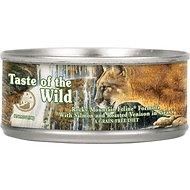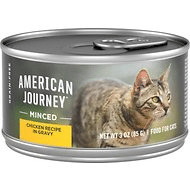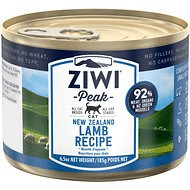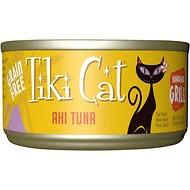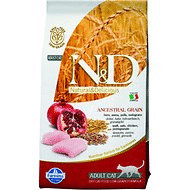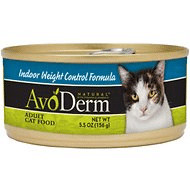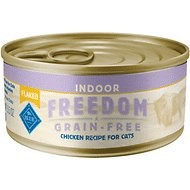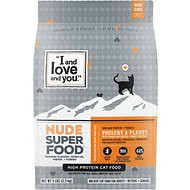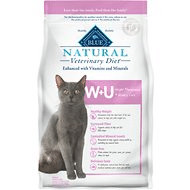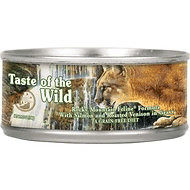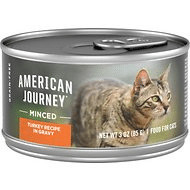Contents
- What Is The Best Food For Diabetic Cats?
- Understanding Diabetes in Cats
- How is Feline Diabetes Managed?
- What to Look for in a Good Cat Food for Diabetic Cats
- How Do We Make Our Recommendations?
- The 10 Best Foods for Diabetic Cats
- 6 More Top-Rated Cat Foods for Diabetic Cats
- Tiki Cat Hawaiian Grill Ahi Tuna Grain-Free Canned Food
- Farmina Natural & Delicious Chicken & Ancestral Low-Grain Formula Dry Food
- AvoDerm Natural Indoor Weight Control Formula Adult Canned Food
- Blue Buffalo Freedom Indoor Flaked Chicken Recipe Grain-Free Canned Food
- I and Love and You Nude Food Poultry a Plenty Grain-Free Dry Cat Food
- Blue Buffalo Natural Veterinary Diet W+U Weight Management + Urinary Care Grain-Free Diet
- Frequently Asked Questions
Over 30 million people in the United States have diabetes – that’s nearly 10% of the country’s population. Of those, only 23 million people have been diagnosed, leaving about 7 million people undiagnosed. Spurred in part by the obesity epidemic, diabetes has become a serious problem in people, and it has even started to become more common in pets.
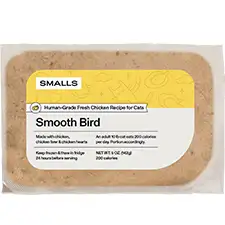
Smalls Human-Grade Ground Bird Fresh Cat Food
-
- Natural sources of taurine
- High in protein
It is estimated that between 0.2% and 1% of cats in the general population suffer from diabetes. As is true for people, cats can develop two different types of diabetes. Type II is the most common form, though Type I does happen from time to time. Unfortunately, the symptoms of diabetes are sometimes easy to miss which leads to delayed diagnosis. In severe cases, undiagnosed and untreated diabetes in cats can lead to a worsening of symptoms.
In this article, we’ll explore the subject of feline diabetes in greater depth to learn what it is, what causes it, and how it can be treated and managed. You’ll also receive some advice for feeding a diabetic cat and see our low carb cat food list to help you pick the best cat food for diabetes.
What Is The Best Food For Diabetic Cats?
- Small Ground Bird Human-Grade Fresh Cat Food
- Taste of the Wild Rocky Mountain Grain-Free
- American Journey Minced Chicken Recipe
- Ziwi Peak Lamb Recipe Canned Cat Food
- Tiki Cat Hawaiian Grill Ahi Tuna Grain-Free
- Farmina Natural & Delicious Chicken & Ancestral
- AvoDerm Natural Indoor Weight Control
- Blue Buffalo Freedom Indoor Flaked Chicken
- I and Love and You Nude Food Poultry a Plenty
- Blue Buffalo Natural Veterinary Diet W+U
Understanding Diabetes in Cats
Feline diabetes or diabetes mellitus is a condition in which the body either fails to product enough insulin or has a diminished response to insulin. Insulin is a hormone secreted by the body after eating that allows the cells and tissues on the body to absorb glucose from the blood stream to use it as energy. In a way, the insulin “unlocks” the doors to the cells, allowing them to absorb glucose. As blood sugar levels rise, so should insulin levels. As the glucose is absorbed from the blood stream, those blood sugar and glucose levels drop back down to normal.
In a cat with diabetes, there are problems with this process. Cats with Type I diabetes fail to produce enough insulin which means that blood sugar levels remain elevated. Cats with Type II diabetes don’t respond properly to insulin which keeps blood sugar levels high. Type II diabetes is the most common form in cats and both types have similar symptoms.
Here are some of the most common symptoms of feline diabetes:
- Urinating more frequently
- Unexplained weight loss
- Excessive thirst
- Overweight or obesity
- Muscle wasting in the back
- Increased hunger
- Lethargy
- Nerve problems, changes in gait
Though diabetes in cats may not seem like a serious problem, it can lead to complications if left untreated. Chronically elevated blood sugar levels can be damaging to the body and may lead to nerve damage (called neuropathy) that might affect the cat’s muscles and his ability to walk. Risk factors such as obesity, increasing age, and low activity levels can worsen these symptoms. In mild cases, however, feline diabetes can be transient. Prompt treatment is insulin injections, healthy weight loss, and changes in diet can resolve the issue and prevent it from becoming a long-term disease.
Now that you understand the basics about feline diabetes, you may be wondering which is the best treatment for your cat. In the next section, we’ll talk about options for diabetes treatment and management and we’ll explore how changing your cat’s diet might help.
How is Feline Diabetes Managed?
The good news about feline diabetes is that there are treatment options and it can be managed. It is important to remember, however, that while diabetes isn’t a death sentence, it isn’t something you should ignore. With proper treatment and management, you could resolve your cat’s diabetes in a year or two. Without treatment, however, your cat’s condition could worsen, and he may develop secondary health problems that could shorten his lifespan and affect his quality of life.
The best treatment for feline diabetes will vary depending how early the condition is diagnosed and which type of diabetes your cat has. The sooner you notice symptoms and report them to your doctor, the sooner he can make a diagnosis and start your cat on insulin treatments. Short-term insulin injections can prevent long-term damage to your cat’s pancreas which might make the condition permanent. Even with prompt treatment, however, your cat will require close veterinary monitoring with frequent blood tests to check his glucose and insulin levels.
In addition to making sure your cat gets the veterinary care he requires, you may also need to make dietary changes to help manage his condition. When it comes to dietary management of diabetes, you need to remember your cat’s basic nutritional requirements, first and foremost. Cats are obligate carnivores which means they have a biological need for protein in their diets. Ideally, 50% of their daily calories should come form protein and 20% to 45% from fat. Only 1% to 2% of your cat’s daily calories should come from carbohydrates, so you may want to familiarize yourself with a low carb cat food list. Aside from that, high moisture levels can also be beneficial for diabetic cats.
What to Look for in a Good Cat Food for Diabetic Cats
When it comes to feeding your diabetic cat, you have two options: a prescription diet or a non-prescription food for diabetic cats. If your cat’s condition is severe and he needs to gain or lose a significant amount of weight, you may want to consider a prescription diet. It might be the best way to ensure that he gets the nutrition he needs to support his recovery. Just make sure that you evaluate the food yourself to determine whether it is a high-quality product.
If you decide on a non-prescription food for diabetic cats, you’ll find that you have a wide variety of options to choose from. Your cat’s basic nutritional requirements come first, but there are some additional things to look for in the best food for diabetic cats.
Here are some of the things we look for in a good cat food feline diabetes:
- Real animal proteins. All cats require a high level of protein in their diets and it is best from animal sources like meat, poultry, and fish. Animal proteins are more digestible and biologically valuable for your cat, so make sure they are the first ingredient in any recipe you choose.
- Moderate healthy fat content. Fat provides a concentrated source of calories for cats as well as essential fatty acids. If your cat is obese or overweight, you want to control the fat content of his diet to control the calories. Just remember that cats do require some fat, ideally from animal sources, to ensure a balanced diet with essential fatty acids like omega-3s and omega-6s.
- Low carbohydrate content. A low-carb diet is recommended particularly for diabetic cats, though all cats have a limited ability to digest carbohydrate ingredients. Aim for no more than 10% of your cat’s calories to come from carbohydrates because a high-carb diet will elevate your cat’s blood sugar levels and make his diabetes more difficult to manage.
- Highly digestible ingredients. The more digestible your cat’s diet is, the better. High-quality, natural ingredients are more digestible and fresh foods like whole grains and vegetables have a lesser impact on your cat’s blood sugar levels.
- No artificial additives. Artificial colors, flavors, and preservatives have no place in your cat’s diet. Avoid anything that contains low-quality grains like corn, wheat, and soy which can cause spikes in blood sugar. You should also avoid by-products and artificial additives.
- Higher moisture content. Increased moisture content in cat food makes it more digestible. Plus, cats with diabetes tend to need higher amounts of moisture in their diet. Look for a low carb canned food for diabetic cats if you want to meet his needs for moisture.
Now that you’ve learned what your cat needs in terms of diet, you may be looking for a low carb cat food list to get you started in your search. We’ve compiled a collection of our top picks for the best wet cat food and best dry cat food for diabetic cats below. Before checking out our selections, however, you should take a moment to learn how we make our recommendations.
How Do We Make Our Recommendations?
Balanced nutrition is essential for all cats, not just cats with diabetes. It is important to remember that cats have a biological requirement for high levels of protein in their diets with moderate amounts of fat and low carbohydrate content. In addition to checking the nutritional levels in every cat food we recommend, we also take a look at the ingredients to ensure that the sources for those key nutrients are nutritious and of high quality. We would never recommend a cat food that we wouldn’t feel comfortable feeding our own pets, so rest easy!
Here are some of the requirements for a cat food to receive our recommendation:
- A source of high-quality animal protein as the first ingredient
- At least 30% crude protein for kittens and at least 26% for adults
- A minimum of 9% crude fat for kittens and adults
- A balance of omega-3 and omega-6 fatty acids, primarily from animal sources
- A rich blend of nutrients from natural sources and supplements, as needed
- Limited carbohydrate content from digestible sources (like whole grains and veggies)
- No low-quality fillers, by-products, or artificial additives (preservatives, dyes, or flavors)
The 10 Best Foods for Diabetic Cats
The best food for diabetic cats is one that will provide for his basic nutritional requirements without spiking his blood sugar. This means a diet high in protein with moderate fat content and low carbohydrate content. Whether you’re looking for a dry food recipe or the best wet food recipe, we’ve compiled a list of options below. Here are our top picks for the best food for diabetic cats:
| Our 2024 Picks: Best Foods for Diabetic Cats | |||
Small Ground Bird Human-Grade Fresh Cat Food
|
CHECK PRICE | ||
Taste Of The Wild Rocky Mountain Grain-Free
|
CHECK PRICE | ||
American Journey Minced Chicken Recipe In Gravy
|
CHECK PRICE | ||
Ziwi Peak Lamb Recipe Canned Food
|
CHECK PRICE | ||
Tiki Cat Hawaiian Grill Ahi Tuna Grain-Free
|
CHECK PRICE | ||
Farmina Natural & Delicious Chicken & Ancestral
|
CHECK PRICE | ||
AvoDerm Natural Indoor Weight Control Formula
|
CHECK PRICE | ||
Blue Buffalo Freedom Indoor Flaked Chicken Recipe
|
CHECK PRICE | ||
I and Love and You Nude Food Poultry a Plenty
|
CHECK PRICE | ||
Blue Buffalo Natural Veterinary Diet W+U
|
CHECK PRICE | ||
Small Ground Bird Human-Grade Fresh Cat Food
Overall Best Food for Diabetes: When it comes to chronic health problems like diabetes, many pet owners wonder if switching their cat to a homemade diet is the best option. After all, homemade cat food recipes allow you to have complete control over what your cat is eating. The problem is that it can be tough to ensure nutritional balance with a homemade diet. That’s why we recommend Smalls as an alternative to homemade cat food. Smalls is a fresh pet food delivery service that sends pre-portioned packages of fresh cat food right to your door. Simply provide some basics information about your cat’s age, weight, and activity level and they will determine the appropriate number of calories and send packages that contain the perfect amount of food. This is fresh food made with high-quality, natural ingredients so you can rest assured that it will nourish your cat’s body and help with his diabetes. It has a higher moisture content than dry kibble and is highly nutritious. If your cat needs to lose weight, simply select the option for weight loss and Smalls will calculate your cat’s calorie needs.
- Pros: Fresh food delivered to your door, rich in animal protein and moisture, digestible natural ingredients, complete and balanced, customized to your cat’s calorie needs
- Cons: Only two recipes to choose from, significantly more expensive than traditional kibble
Taste of the Wild Rocky Mountain Grain-Free Canned Food
Most Popular Cat Food for Diabetes: There are many different brands of cat food out there, so it can be tough to choose one for your diabetic cat. If you’re struggling to make a decision, consider a popular brand like Taste of the Wild. This brand uses premium quality proteins, particularly smoked meats, to ensure bioavailability for your cat as well as natural flavor. This particular recipe features fresh trout as the main ingredient with ocean fish and smoked salmon as supplemental proteins. It is a canned food which means that it is rich in moisture and lower in carbohydrate content than the typical dry food. It is grain-free as well, relying on potatoes and other root vegetables for carbohydrates and fiber. Plus, it is complete and balanced to provide for all of your cat’s nutritional needs through the use of healthy, high-quality ingredients.
- Pros: Rich in animal protein, highly digestible, high in moisture content, rich in real meat flavor, digestible grain-free carbohydrates, complete and balanced nutrition
- Cons: May contain more starch than some cats need
American Journey Minced Chicken Recipe in Gravy Grain-Free Canned Food
Most Affordable Cat Food for Diabetes: The best food you can buy would be very expensive, but you don’t necessarily have to spend a lot to feed your cat well. The American Journey brand is highly affordable and offers good nutritional quality as well. This canned cat food recipe is a great choice for diabetic cats because it is rich in moisture and real animal protein with limited carbohydrate content. This formula features fresh salmon as the main ingredient with supplemental protein from chicken liver, tuna, chicken, and eggs. It is complete and balanced with the help of fresh fruits and vegetables as natural sources for key nutrients with vitamin and chelated mineral supplements as needed.
- Pros: Affordable price, rich in animal protein, high-quality natural ingredients, complete and balanced nutrition, rich in moisture and flavor, chelated mineral supplements
- Cons: Not a single-source protein recipe
Ziwi Peak Lamb Recipe Canned Cat Food
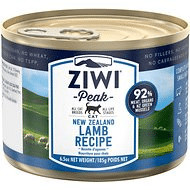
- Pros: High in animal protein, single source of protein, limited carbohydrate content, highly digestible recipe, complete and balanced nutrition, chelated mineral supplements
- Cons: May be higher in fat than some cats need
6 More Top-Rated Cat Foods for Diabetic Cats
Choosing the perfect cat food recipe can be tough, so don’t limit yourself! Consider all of the options to choose the one that is the best fit for your diabetic cat. Here are 6 more options:
Tiki Cat Hawaiian Grill Ahi Tuna Grain-Free Canned Food
If you’re looking for a low carb canned food for diabetic cats, the Tiki Cat brand is a great choice. This particular recipe features fresh tuna as the main ingredient with tuna broth and sunflower seed oil as the only other main ingredient. This recipe is high in animal protein and moisture but contains no carbohydrate ingredients. It delivers complete and balanced nutrition with the help of vitamins and mineral supplements, not to mention plenty of real fish flavor. If your cat requires a high-fiber diet, this is not the right choice but if you are trying to keep your cat’s diet very low-glycemic, it could work.
Farmina Natural & Delicious Chicken & Ancestral Low-Grain Formula Dry Food
Some cats simply prefer dry food which can make it difficult to make the right choice if your cat is diabetic. Dry foods tend to be higher in carbohydrate content but this Farmina Natural & Delicious Chicken & Ancestral Low-Grain Formula is not. It contains 60% animal ingredients with 20% organic spelt and organic oats and 20% vegetables, fruits, and supplements. It is a low-glycemic formula which means that it will have a reduced impact on your cat’s blood sugar levels. It contains 94% protein from premium animal sources including boneless chicken, dehydrated chicken, and dehydrated herring. It also contains dried fruits and vegetables to provide natural sources for key vitamins and minerals.
AvoDerm Natural Indoor Weight Control Formula Adult Canned Food
Many diabetic cats struggle with overweight or obesity which can make their condition more difficult to manage. If you’re looking for a nutritious wet food that will be appropriate for your cat’s diabetes and also help him lose weight, consider this AvoDerm Natural Indoor Weight Control Formula. This formula features fresh chicken as the main ingredient with chicken liver and tuna as supplemental sources of protein. It contains chicken broth for moisture and flavor, and it is formulated specifically for the lower activity levels of indoor cats. This recipe contains a rich blend of omega-3 and omega-6 fatty acids for healthy skin and coat, plus it is complete and balanced to ensure optimal nutrition.
Blue Buffalo Freedom Indoor Flaked Chicken Recipe Grain-Free Canned Food
Another great option in canned cat food for indoor cats is this Blue Buffalo Freedom Indoor Flaked Chicken Recipe. This formula is completely grain-free and rich in protein with real chicken as the first ingredient. It contains a rich blend of omega-3 and omega-6 fatty acids to promote healthy skin and coat with zero grains, fillers, or by-products to ensure digestibility. This recipe is made with real broth for increased moisture levels as well as plenty of natural flavor. You’ll also find fresh fruits and vegetables as natural sources for key vitamins and minerals to ensure complete and balanced nutrition.
I and Love and You Nude Food Poultry a Plenty Grain-Free Dry Cat Food
If you’re looking for another option in dry food for diabetic cats, consider this I and Love and You Nude Food Poultry a Plenty recipe. It is high in protein and grain-free, supplemented with nutrient-rich superfoods like chia seeds, olive oil, and green mussels. It features fresh turkey, chicken meal, and turkey meal as the top three ingredients with rich sources of omega-3 and omega-6 fatty acids for healthy skin and coat. This is a low-glycemic recipe as well, supplemented with digestive enzymes, fiber, and probiotics for healthy and regular digestion. Plus, it contains a significant amount of animal protein with moderate fat and calorie content to support your cat’s healthy body weight.
Blue Buffalo Natural Veterinary Diet W+U Weight Management + Urinary Care Grain-Free Diet
If your cat requires a prescription diet, this Blue Buffalo Natural Veterinary Diet is one we recommend. Unlike many of the most popular prescription diets, it contains no by-products, fillers, or artificial ingredients. This recipe is formulated to support healthy weight management and it contains plenty of moisture and fiber to help manage your cat’s diabetes. It contains controlled levels of vitamins and minerals to ensure complete and balanced nutrition and it is wholesome and all-natural for digestibility.
Frequently Asked Questions
- What is the best food for a diabetic cat? The best food for a diabetic cat is one that meets his basic nutritional requirements while helping him manage his diabetes. This means a high-protein diet with moderate fat content and low carbohydrate content. There are many different cat foods that meet these requirements, so you will be able to shop around and find one that also meets your cat’s dietary preferences.
- How many times a day do you feed a diabetic cat? When it comes to managing feline diabetes, the goal is to keep your cat’s blood sugar levels as stable as possible. When your cat eats, you can expect his blood sugar to rise, so it is important to time his meals to coincide with his insulin injections. In most cases, diabetic cats do well with two meals per day. You should try to feed the same amount of food on the same schedule every day for the best results.
- Should diabetic cats eat dry food? Dry food is the preferred option for many cat owners, but it may not be the best choice for diabetic cats. Cats with diabetes require a higher level of moisture in their diet and dry food tends to only have about 10% moisture. A canned food diet contains somewhere between 78% and 82%, so it is worth considering making the switch for your cat.
- Is grain free cat food good for diabetic cats? Generally speaking, grains are a nutritious source of carbohydrates and essential nutrients for cats. Grain allergies are not as common as some pet food manufacturers would have you believe, so it is really only necessary to feed your cat a grain free diet if he has a confirmed allergy or sensitivity. When it comes to diabetic cats, however, things may be slightly different. Grains like corn, wheat, and soy will have a significant impact on your cat’s blood sugar levels while whole grains like brown rice, oatmeal, and barley have a lesser effect (as long as they are unrefined). Vegetables are also less likely to significantly impact blood sugar than fillers. Whether you feed your cat a grain free diet is up to you, but be sure the carbohydrates in your cat’s food are highly digestible and have a low glycemic impact.
- How do cats get diabetes? For some cats, diabetes is a condition they inherit. Type I diabetes is characterized by the cat’s inability to produce enough insulin which is typically an issue that involves problems with the pancreas. With Type II diabetes, the cat has trouble utilizing insulin properly. This too can be related to issues with the pancreas but can also be related to obesity and other underlying health problems. To determine the underlying cause of your cat’s diabetes, you should talk to your veterinarian.
Feline diabetes is a very manageable condition, but that doesn’t make it insignificant. In many cats, diabetes is related to obesity and obesity can increase your cat’s risk for a variety of other serious health problems. No matter what type of diabetes your cat has and how he got it, it is your responsibility to seek veterinary care and to properly manage the condition.
Feeding your cat the right diet can help, so take what you’ve learned here to choose the best food for diabetes in cats. If you’re not sure where to start your search, simply try one of the options we’ve recommended above! Good luck!

